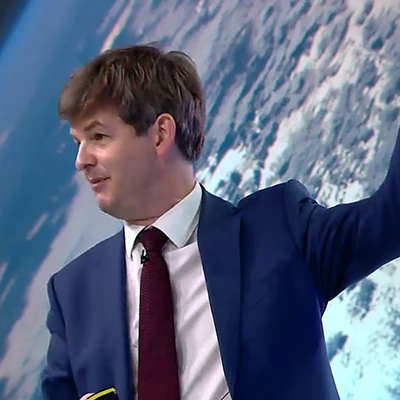
A team of academics from the University of Cambridge is working with aviation industry leaders to develop an interactive website that shows the climate and environmental impacts of potential alternative fuels to decarbonize air travel.
The Aviation Impact Accelerator (AIA) group’s modeling work allows users to select options throughout the entire air travel system, including material sourcing and fuel transport, to map out the emissions and impacts of the industry as a whole.
Policy makers and practitioners can test new aircraft technologies in different situations to determine how to best decarbonize airplanes and discover the tradeoffs.
 Rob Miller of the University of Cambridge presents the Aviation Impact Accelerator’s simulator website at the U.N. Climate Change Conference (COP26) in Glasgow, Scotland, on Wednesday. | UN Climate Change Conference UK 2021
Rob Miller of the University of Cambridge presents the Aviation Impact Accelerator’s simulator website at the U.N. Climate Change Conference (COP26) in Glasgow, Scotland, on Wednesday. | UN Climate Change Conference UK 2021“It’s probably the best sector to decarbonize,” said Rob Miller, director of The Whittle Laboratory at the University of Cambridge. He presented the model at the United Nations Climate Change Conference (COP26) in Glasgow, Scotland, on Wednesday.
The user-friendly interface is similar to Google Maps. There are several technologies the industry is exploring, from green hydrogen to creating power through electrolysis with water, and “making a decision is incredibly difficult,” Miller said. “We have to be very careful with the routes we choose.”
Electric planes are also emerging as an option for short-range flights, which could change the aviation system if planes need to be replaced between trips instead of refueled, Heathrow Airport CEO John Holland-Kaye said.
The options have uncertainties around the behavioral and policy changes required, though pilot projects have begun in Europe. But “there is a consensus that we need to decarbonize” in the industry, including manufacturers and investors, Holland-Kaye said at the COP26 presentation Wednesday. “We just need policies from the government to make it easier for us.”
Before the COVID-19 pandemic, aviation was responsible for 3% of global annual CO2 emissions, according to U.K. government data. In the U.S., aviation accounts for 9% of greenhouse gas emissions from the transportation sector.
And the United Nations expects airplane emissions of carbon dioxide to triple by 2050. Newer plane models are more efficient, but demand for flights is growing.
“We need to move fast,” Holland-Kaye said.
Other types of emissions from flying, such as methane, are thought to have an even more detrimental impact on the climate, according to the International Council on Clean Transportation. Avoiding flying is often top of the list in explainers on how individuals can make a difference for climate change.
The model AIA developed will help the public understand what is involved in cutting emissions from airplanes, and “pressure governments to make the change,” Miller said.
The idea for the website was inspired by David MacKay’s Carbon Calculator, where users could explore pathways to reduce the U.K.’s GHG emissions.
“It helps to show where the focus needs to be,” Holland-Kaye said.
Clean Flights by 2050
On Tuesday, the U.S. launched a plan to reach net-zero emissions in its aviation sector by 2050.
“The U.S. Aviation Climate Action Plan … is ambitious yet achievable, and will help create a sustainable aviation future,” U.S. Transportation Secretary Pete Buttigieg said during COP26 for the plan’s launch.
In the plan, the Federal Aviation Administration sets out a suite of approaches that touch on aviation technology improvements, advancements in sustainable aviation fuels and implementation of new incentives and policies.
“While many U.S. airlines use carbon offsets or invite their customers to use carbon offsets, on a voluntary basis, these efforts are generally not harmonized across industry, and there are no broadly applicable standards to ensure accurate accounting and avoid double-counting and double-claiming within and across sectors,” the plan said.
The plan says the FAA will consult with stakeholders on options for policies and programs and assess legal authorities to advance additional tools in support of the 2050 goal.


